2005 CHEVROLET SILVERADO ECU
[x] Cancel search: ECUPage 7 of 580
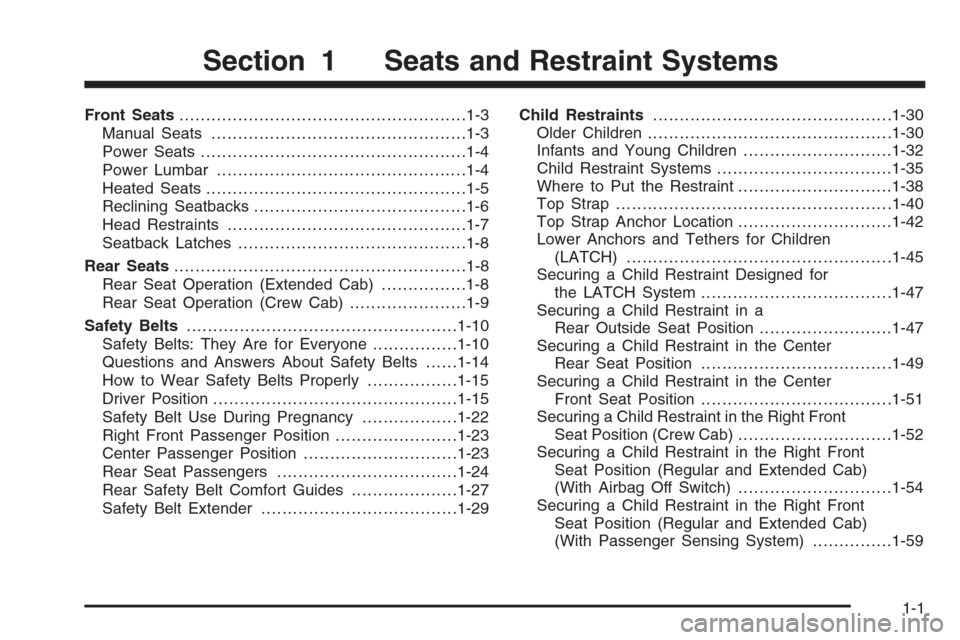
Front Seats......................................................1-3
Manual Seats................................................1-3
Power Seats..................................................1-4
Power Lumbar ...............................................1-4
Heated Seats.................................................1-5
Reclining Seatbacks........................................1-6
Head Restraints.............................................1-7
Seatback Latches...........................................1-8
Rear Seats.......................................................1-8
Rear Seat Operation (Extended Cab)................1-8
Rear Seat Operation (Crew Cab)......................1-9
Safety Belts...................................................1-10
Safety Belts: They Are for Everyone................1-10
Questions and Answers About Safety Belts......1-14
How to Wear Safety Belts Properly.................1-15
Driver Position..............................................1-15
Safety Belt Use During Pregnancy..................1-22
Right Front Passenger Position.......................1-23
Center Passenger Position.............................1-23
Rear Seat Passengers..................................1-24
Rear Safety Belt Comfort Guides....................1-27
Safety Belt Extender.....................................1-29Child Restraints.............................................1-30
Older Children..............................................1-30
Infants and Young Children............................1-32
Child Restraint Systems.................................1-35
Where to Put the Restraint.............................1-38
Top Strap....................................................1-40
Top Strap Anchor Location.............................1-42
Lower Anchors and Tethers for Children
(LATCH)..................................................1-45
Securing a Child Restraint Designed for
the LATCH System....................................1-47
Securing a Child Restraint in a
Rear Outside Seat Position.........................1-47
Securing a Child Restraint in the Center
Rear Seat Position....................................1-49
Securing a Child Restraint in the Center
Front Seat Position....................................1-51
Securing a Child Restraint in the Right Front
Seat Position (Crew Cab).............................1-52
Securing a Child Restraint in the Right Front
Seat Position (Regular and Extended Cab)
(With Airbag Off Switch).............................1-54
Securing a Child Restraint in the Right Front
Seat Position (Regular and Extended Cab)
(With Passenger Sensing System)...............1-59
Section 1 Seats and Restraint Systems
1-1
Page 15 of 580
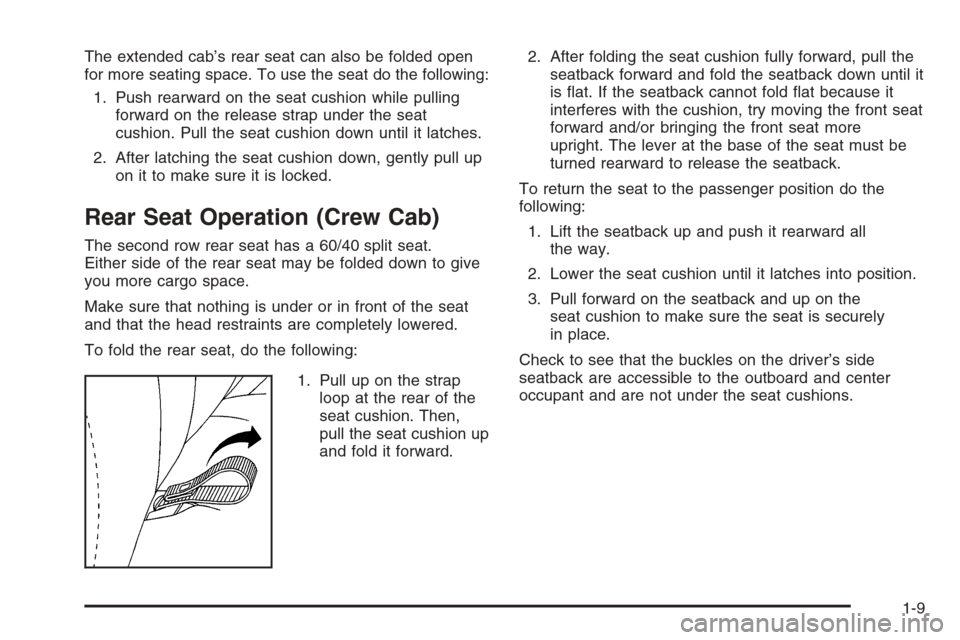
The extended cab’s rear seat can also be folded open
for more seating space. To use the seat do the following:
1. Push rearward on the seat cushion while pulling
forward on the release strap under the seat
cushion. Pull the seat cushion down until it latches.
2. After latching the seat cushion down, gently pull up
on it to make sure it is locked.
Rear Seat Operation (Crew Cab)
The second row rear seat has a 60/40 split seat.
Either side of the rear seat may be folded down to give
you more cargo space.
Make sure that nothing is under or in front of the seat
and that the head restraints are completely lowered.
To fold the rear seat, do the following:
1. Pull up on the strap
loop at the rear of the
seat cushion. Then,
pull the seat cushion up
and fold it forward.2. After folding the seat cushion fully forward, pull the
seatback forward and fold the seatback down until it
is �at. If the seatback cannot fold �at because it
interferes with the cushion, try moving the front seat
forward and/or bringing the front seat more
upright. The lever at the base of the seat must be
turned rearward to release the seatback.
To return the seat to the passenger position do the
following:
1. Lift the seatback up and push it rearward all
the way.
2. Lower the seat cushion until it latches into position.
3. Pull forward on the seatback and up on the
seat cushion to make sure the seat is securely
in place.
Check to see that the buckles on the driver’s side
seatback are accessible to the outboard and center
occupant and are not under the seat cushions.
1-9
Page 22 of 580
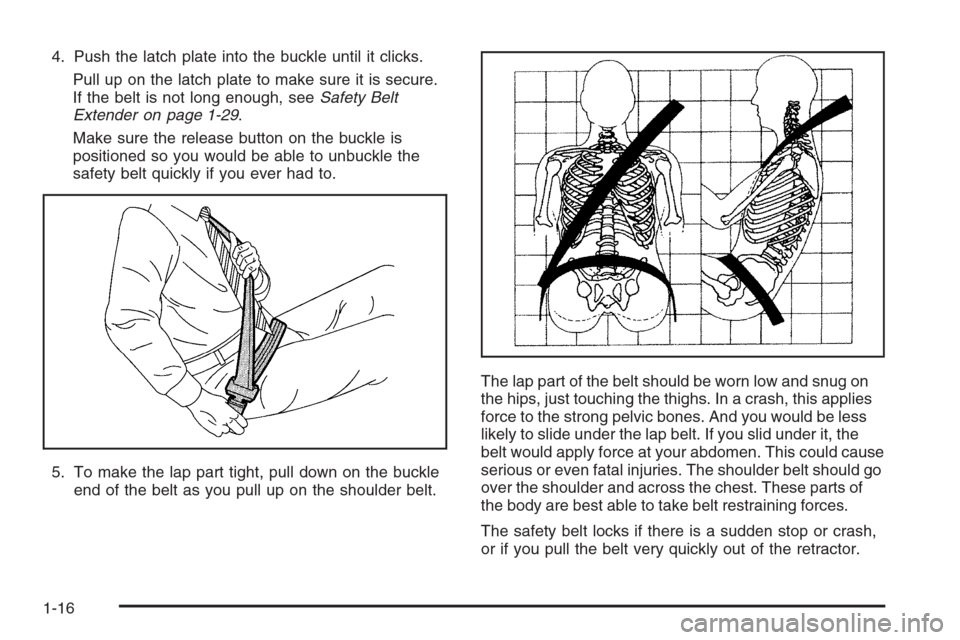
4. Push the latch plate into the buckle until it clicks.
Pull up on the latch plate to make sure it is secure.
If the belt is not long enough, seeSafety Belt
Extender on page 1-29.
Make sure the release button on the buckle is
positioned so you would be able to unbuckle the
safety belt quickly if you ever had to.
5. To make the lap part tight, pull down on the buckle
end of the belt as you pull up on the shoulder belt.The lap part of the belt should be worn low and snug on
the hips, just touching the thighs. In a crash, this applies
force to the strong pelvic bones. And you would be less
likely to slide under the lap belt. If you slid under it, the
belt would apply force at your abdomen. This could cause
serious or even fatal injuries. The shoulder belt should go
over the shoulder and across the chest. These parts of
the body are best able to take belt restraining forces.
The safety belt locks if there is a sudden stop or crash,
or if you pull the belt very quickly out of the retractor.
1-16
Page 31 of 580
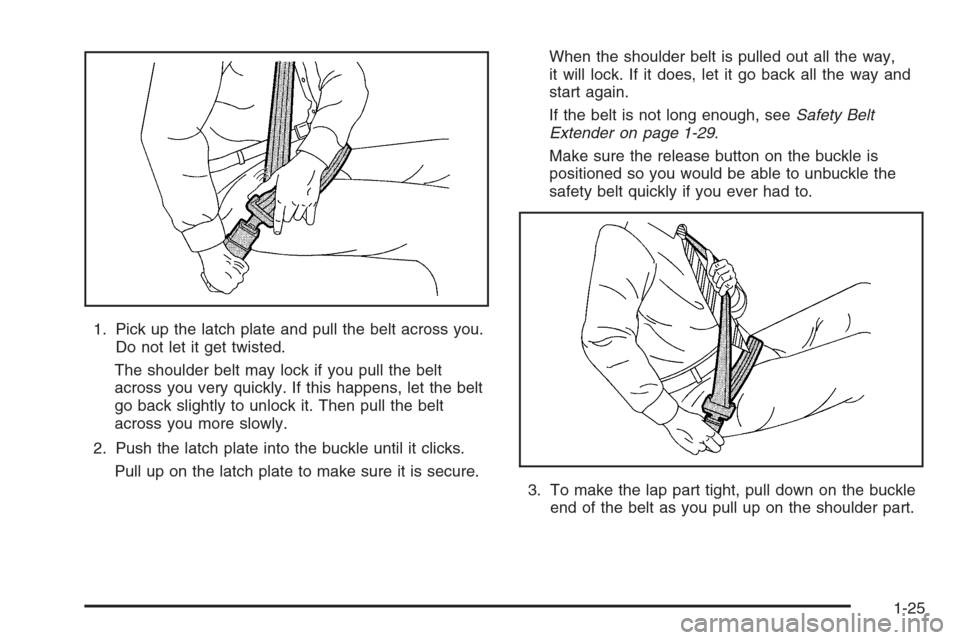
1. Pick up the latch plate and pull the belt across you.
Do not let it get twisted.
The shoulder belt may lock if you pull the belt
across you very quickly. If this happens, let the belt
go back slightly to unlock it. Then pull the belt
across you more slowly.
2. Push the latch plate into the buckle until it clicks.
Pull up on the latch plate to make sure it is secure.When the shoulder belt is pulled out all the way,
it will lock. If it does, let it go back all the way and
start again.
If the belt is not long enough, seeSafety Belt
Extender on page 1-29.
Make sure the release button on the buckle is
positioned so you would be able to unbuckle the
safety belt quickly if you ever had to.
3. To make the lap part tight, pull down on the buckle
end of the belt as you pull up on the shoulder part.
1-25
Page 35 of 580
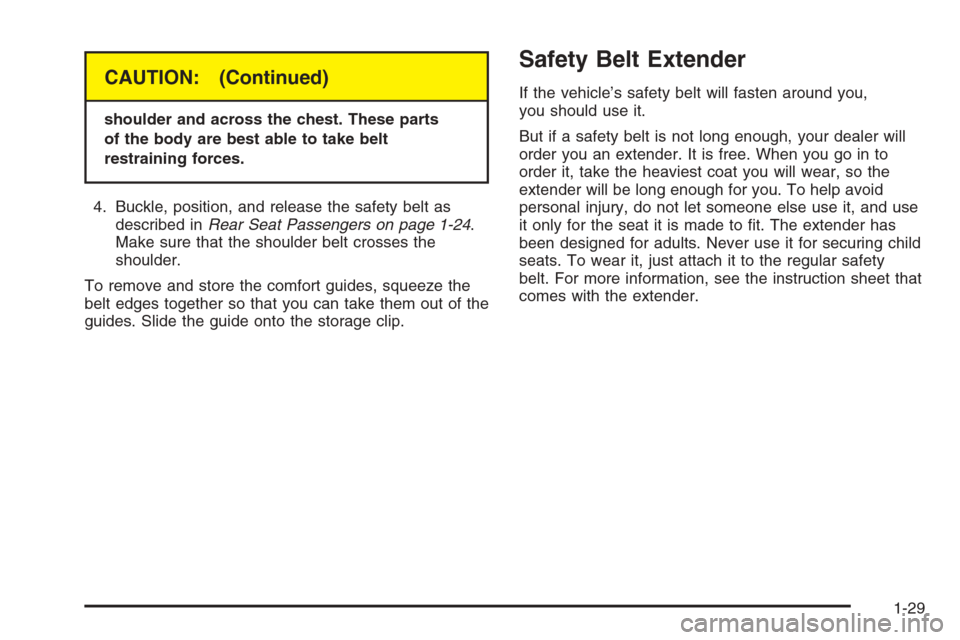
CAUTION: (Continued)
shoulder and across the chest. These parts
of the body are best able to take belt
restraining forces.
4. Buckle, position, and release the safety belt as
described inRear Seat Passengers on page 1-24.
Make sure that the shoulder belt crosses the
shoulder.
To remove and store the comfort guides, squeeze the
belt edges together so that you can take them out of the
guides. Slide the guide onto the storage clip.
Safety Belt Extender
If the vehicle’s safety belt will fasten around you,
you should use it.
But if a safety belt is not long enough, your dealer will
order you an extender. It is free. When you go in to
order it, take the heaviest coat you will wear, so the
extender will be long enough for you. To help avoid
personal injury, do not let someone else use it, and use
it only for the seat it is made to �t. The extender has
been designed for adults. Never use it for securing child
seats. To wear it, just attach it to the regular safety
belt. For more information, see the instruction sheet that
comes with the extender.
1-29
Page 39 of 580
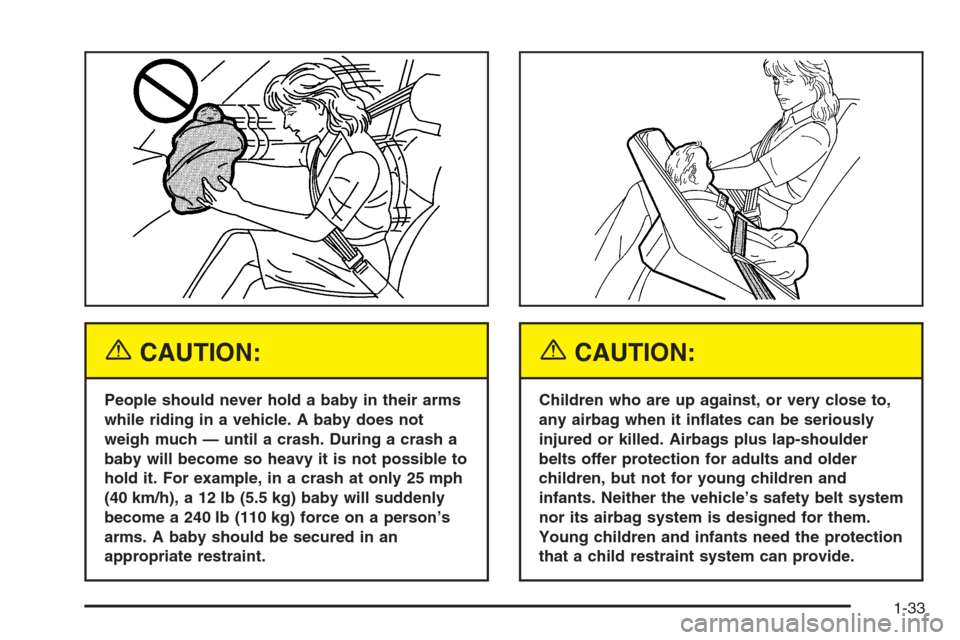
{CAUTION:
People should never hold a baby in their arms
while riding in a vehicle. A baby does not
weigh much — until a crash. During a crash a
baby will become so heavy it is not possible to
hold it. For example, in a crash at only 25 mph
(40 km/h), a 12 lb (5.5 kg) baby will suddenly
become a 240 lb (110 kg) force on a person’s
arms. A baby should be secured in an
appropriate restraint.
{CAUTION:
Children who are up against, or very close to,
any airbag when it in�ates can be seriously
injured or killed. Airbags plus lap-shoulder
belts offer protection for adults and older
children, but not for young children and
infants. Neither the vehicle’s safety belt system
nor its airbag system is designed for them.
Young children and infants need the protection
that a child restraint system can provide.
1-33
Page 40 of 580
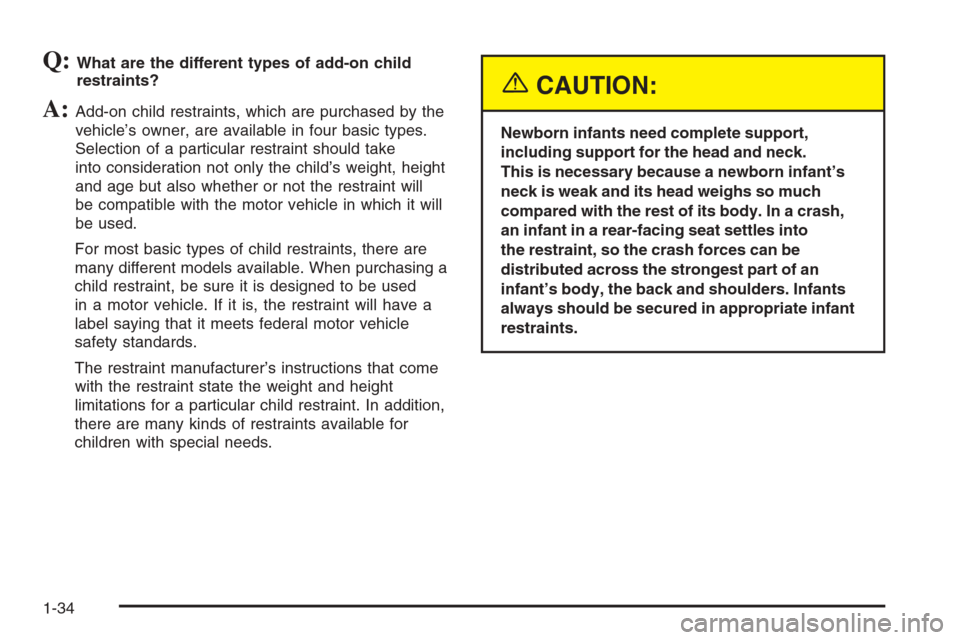
Q:What are the different types of add-on child
restraints?
A:Add-on child restraints, which are purchased by the
vehicle’s owner, are available in four basic types.
Selection of a particular restraint should take
into consideration not only the child’s weight, height
and age but also whether or not the restraint will
be compatible with the motor vehicle in which it will
be used.
For most basic types of child restraints, there are
many different models available. When purchasing a
child restraint, be sure it is designed to be used
in a motor vehicle. If it is, the restraint will have a
label saying that it meets federal motor vehicle
safety standards.
The restraint manufacturer’s instructions that come
with the restraint state the weight and height
limitations for a particular child restraint. In addition,
there are many kinds of restraints available for
children with special needs.
{CAUTION:
Newborn infants need complete support,
including support for the head and neck.
This is necessary because a newborn infant’s
neck is weak and its head weighs so much
compared with the rest of its body. In a crash,
an infant in a rear-facing seat settles into
the restraint, so the crash forces can be
distributed across the strongest part of an
infant’s body, the back and shoulders. Infants
always should be secured in appropriate infant
restraints.
1-34
Page 41 of 580
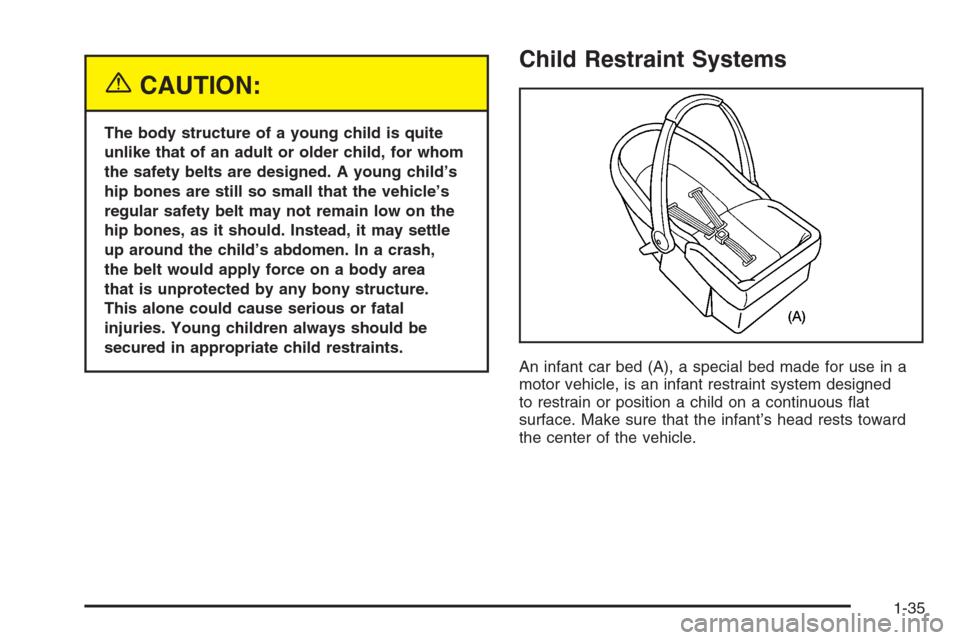
{CAUTION:
The body structure of a young child is quite
unlike that of an adult or older child, for whom
the safety belts are designed. A young child’s
hip bones are still so small that the vehicle’s
regular safety belt may not remain low on the
hip bones, as it should. Instead, it may settle
up around the child’s abdomen. In a crash,
the belt would apply force on a body area
that is unprotected by any bony structure.
This alone could cause serious or fatal
injuries. Young children always should be
secured in appropriate child restraints.
Child Restraint Systems
An infant car bed (A), a special bed made for use in a
motor vehicle, is an infant restraint system designed
to restrain or position a child on a continuous �at
surface. Make sure that the infant’s head rests toward
the center of the vehicle.
1-35